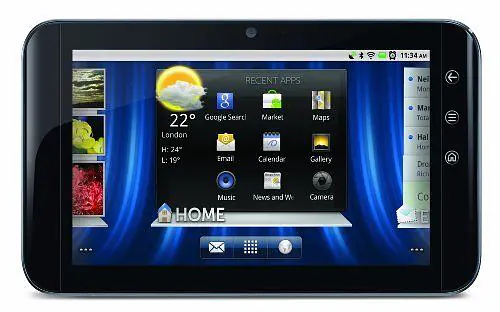New Dell Streak tablet 3g
Regular price
₹4,999.00
Pinch to
zoom
zoom
New Dell Streak tablet 3g
Regular price
₹4,999.00
DESCRIPTION
|
https://www.amazon.in/Dell-Streak-7-Wi-Fi-Tablet/dp/B004QZASJ8
Technical Details
Additional Information
|
Pros
- Clean design, attractive Stage software layer Snappy Tegra 2 processor Fast T-Mobile HSPA+ speeds
Cons
- Low 800 x 480-resolution display Less than six hours of battery life No tablet optimized apps
Hardware

While many slate makers are moving towards the 10-inch form factor, we're still appreciative of the portability of the 7-inch variety. (Yes, so much so that some of us are even dying for a 7-inch iPad.) Like the Galaxy Tab or Archos 7, the Streak 7 lends itself much better to one-handed use than the iPad or any of the other 10-inch tablets we've tested. We loved being able to comfortably hold the 0.48-inch Streak up when reading a book in bed or wrapping both our hands around the 0.9-pound tablet and being able to use our thumbs to type.
Apart from the three capacitive buttons (back, menu, and home), mic, and camera on the front of the tablet, Dell's kept the design very clean. A plastic latch on the right edge, which can be hard to open if you don't have long nails, hides the SD and SIM card slots. The top of the device has a power button and volume rocker, and the left edge a 3.5mm headphone jack. Disappointingly, there's no HDMI output on the device itself; Dell will offer a separate dock that will attach to the PDMI port on the bottom of the device. A quick word on the PDMI port -- it is the same as the one on the original Streak, and because there's no other USB port on the tablet, you've got to have the cord handy to either charge it or connect it to computer to sideload files. Also, our review unit hasn't been charging via USB -- you have to plug it into the wall via its AC adapter. Yeah, it's pretty annoying.
Screen

Even more noticeable is how much brighter the Galaxy Tab's display is. Hands down, Samsung went with a better quality panel than Dell, and it really makes a huge difference considering, you know, the entire tablet experience is centered around the screen. That quality also translates to mediocre viewing angles -- when held horizontally at about 45 degrees, colors start to fade to black. Vertical viewing is better, although in comparison to the Galaxy Tab's screen, which can be seen at virtually every angle, it's yet again just second rate. Beyond all the actual viewing quality issues, the capacitive screen is extremely responsive, and it, along with the Tegra 2 processor, keeps it responding to our taps and flicks quickly. The accelerometer was equally as snappy, though we wish there was a quicker way to disable it than having to go through the display settings menu.
Software

The software experience is the exact same as that on the original Dell's Streak and Venue -- it consists of the Stage UI, which includes Dell's own full-screen widgets and launcher. The widgets are actually useful -- the Home pulls in the local weather and recently used apps, Social your Twitter or Facebook feed, Web a search bar and thumbnails of your bookmarks, and Gallery locally stored pictures. The good news here is that if they aren't your thing, you can easily delete them and customize the panes with regular Android widgets and apps. The launcher at the bottom provides easy access to the browser, app tray, and mail app. We've been trying to figure out how you can customize the launcher, but we haven't come up with a solution yet.
On the topic of that mail app, it nor any of the other native apps, like the calendar or messaging, have been revamped to take advantage of the extra screen real estate. Unlike Samsung, Dell's done no retooling here to take advantage of the larger screen, though considering the resolution is the same as the Streak, it may have just figured it didn't really need to. If we had to sum up the software package, we'd say that you're really just dealing with an oversized smartphone experience here, and while a few months ago that may have been enough for Android tablet seekers, that's about to change as soon as Google releases Honeycomb in the coming days or weeks.
Dell preloads the Steak with quite a few applications. Ours came with BrainPOP (a educational game for kids), Zinio (a magazine app), Kindle, Let's Golf, Blockbuster and Slacker Radio. T-Mobile also throws on its T-Mobile TV and Qik Video Chat apps. It also comes with Swype, though the size of the device lends itself quite nicely to regular thumb typing.
Camera

Performance and battery life

Beyond promising fast performance, Tegra 2 promises full HD playback, and the Streak 7 certainly confirms that. A 1080p clip of Justin Bieber's Never Say Never played with no stuttering or lag, however, that's obviously pretty pointless considering the lower screen resolution. That aforementioned dock with HDMI-out will be the solution for those looking to take advantage of that HD video. Streaming 720p video on YouTube also worked quite well and general Flash performance was pretty decent -- we were able to get some of the New York Times' Flash videos playing within a few seconds of loading the site. The Streak 7 notched an average of 35 MFLOPS in Linpack -- that's considerably better than the Galaxy Tab's 14 MFLOPS.
Sadly, that good performance news turns quite sour when it comes to battery life. There's no way to beat around the bush on this one: the Streak 7's battery life seriously disappoints. In our past few days of usage, the most we've been able to squeeze out of it was about six hours of juice. We powered on the device at 6 pm on Friday evening and after about five hours of intermittent usage on T-Mobile's 4G network -- checking Twitter, e-mails, looking up a few addresses on Google Maps, and surfing the web -- the tablet was totally dead. With just WiFi on, we got closer to six hours of sporadic use. Similarly, on our battery rundown test, which loops the same standard definition video with brightness set at 65 percent and WiFi on, the 2780mAh battery only lasted three hours and 26 minutes. That's halfas long as the Galaxy Tab, and while that's to be expected since the Tab has a larger 4000mAh cell, it really is pretty inexcusable for a highly mobile device like this.
| Battery Life | |
| Dell Streak 7 | 3:26 |
| Archos 70 |
6:00 |
| Archos 101 | 7:20 |
| Samsung Galaxy Tab | 6:09 |
| Apple iPad | 9:33 |
T-Mobile HSPA+ speeds, pricing

T-Mobile offers its usual webConnect broadband plans for the Streak 7: 5GB a month for $50 for new customers and $40 for existing T-Mobile customers. There's also a 200MB plan for $30 a month. There are also prepaid plans which include $10 a week for 100MB, $30 a month for 300MB, and $50 a month for 1GB. As you may have guessed, you can't make phone calls over T-Mobile network with the Streak 7, but you can send text messages.
Wrap-up

For those, that need to have a 7-inch Android tablet right now, we'd suggest the $500 Galaxy Tab -- the screen is noticeably better and it lasts twice as long on a charge. (Keep in mind, we're not positive that the Tab will be upgradable to Honeycomb, so you're taking a risk there). There's also the $250 Nook Color, which is really aimed at reading and light browsing, but can be rooted every which way if that's your thing. However, with the Motorola Xoom, LG G-Slate, Toshiba Tablet, and a handful of other slates on the horizon, what we'd really recommend, is hanging tight and waiting for the Honeycomb tablet era to begin.
%20(1).png)












